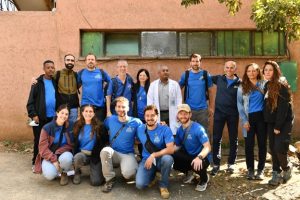On 25 April 2020, the international community marked the World Malaria Day, an occasion set aside to recognise global efforts to control this disease. The global theme is: “Zero malaria starts with me”.
At the International Centre of Insect Physiology and Ecology (icipe), we use this occasion to retrospect on our accomplishments over the past 50 years. The Centre was founded at a time when malaria control in Africa largely focused on diagnosis and treatment. At this point, there was limited attention on mosquitoes; the transmission drivers of malaria. Moreover, the emergence in 1978 of resistance of malaria parasites to chloroquine, which was until then the widely used anti-malaria treatment, underlined the urgency to develop new management strategies. icipe opted to focus on several interrelated but under-researched topics, like the behaviour and ecology of Anopheles mosquitoes.
The Centre has maintained this initial motivation, while also remaining alert and adjusting its research and advocacy efforts in view of evolving challenges in malaria control. For example, in the 1990s, concerned that the world’s attention was over-shifting to emerging health challenges in Africa, icipe was extremely vocal on the need for sustained efforts in control of malaria, a preventable and treatable disease that continued to impact heavily on Africa. Moreover, the Centre cautioned against ‘single bullet’ approaches; instead supporting integrated vector management. Also, icipe was in the frontline in advocating against the use of the environmentally harmful DDT in mosquito control. Indeed, in 2011, icipe was selected as a regional centre under the Stockholm Convention on Persistent Organic Pollutants (POPs).
By the 2000s, there was evident progress in malaria prevalence reduction, largely resulting from intensified use of insecticide treated nets, with significant gains evident by 2015. icipe recognised that the sustainability of these accomplishments was being undermined by various factors. These obstacles include: increasing resistance by mosquitoes to insecticides; adjustments in feeding behaviour of the vectors; and growing ability of the insects to bite people outdoors, as well as a shift in their biting times. As a result, while past efforts had led to reduction of malaria cases by an estimated 40%, from around 2016 there has been a noticeable plateau.
This scenario stipulates the need for continued surveillance and vigilant tracking of changes in vector populations; vector-parasite; vector-host; host-parasite interactions; and malaria transmission patterns. In turn, this knowledge will guide the development of novel or locally adapted strategies to control the disease.
Below is a summary of some of icipe’s achievements over the past 50 years. Basic research 1970 – 1995
• Identification of the local sibling species of the Anopheles gambiae species complex; their egg-laying behaviour; and the population regulation of the sibling species found both in
brackish and freshwater habitats. As a result, icipe pioneered knowledge on the identity of the local vector species in the gambiae species including An. gambiae sensu stricto, An. arabiensis and An. merus.
• These findings also paved way for the development of methods to intercept female mosquitoes as they lay eggs. In addition, the research advanced understanding of local vector systems and species distribution, as well as information on their survival and biting rates.
1995 – 2005
• Advanced knowledge on the larval ecology of mosquitoes, including the environmental and climatic factors affecting the development of the malaria vectors in natural aquatic habitats across the
continent.
• Progress in the identification of mosquito species and subspecies; egg-laying behaviour and bloodmeal sources necessary for the development of eggs.
• Intensified studies on semiochemicals in An. gambiae mosquito that could be exploited to develop novel tools to interrupt contact between this mosquito and people.
• Made the first, and globally exciting report outside laboratory trials, that human foot odour attracts An. gambiae. While this attractiveness had been reported before, confirmation studies under field conditions had largely remained unsuccessful.
• Exposed a growing, and previously largely unexamined trend, on the connection between socioeconomic activities (for example, changes in land use in Africa); and increases, and geographical diversification of malaria incidence and prevalence.
• Revealed cattle as preferred alternative blood-meal hosts of malaria vectors in certain parts of Kenya. Since cattle are ‘dead-end’ hosts of malaria parasites, these findings pointed towards zooprophylaxis – the use of animals to protect people from disease – as a potential strategy for malaria control.
• Develop a proof-of-concept, with encouraging results, on improved development of a malaria drug from Sweet Wormwood (Artemisia annua). This research was based on the recommendation, in 2004, by the World Health Organisation (WHO), for the adoption of Coartem, an artemisinin-based combination therapy (ACT), as the first-line treatment for malaria in Africa. icipe was concerned that the use of purified artemisinin could lead to resistance. Moreover, the Centre hoped that commercial cultivation of A. annua, and the establishment of extraction companies in East Africa, would open up enterprise opportunities, and make the drug more easily accessible and affordable in the continent.
2005 – October 2013
• Advanced chemical ecology studies in the investigation of compounds and their blends to disrupt malaria transmission. Attractive odours that significantly affect mosquito behaviour were evaluated to assess their competitiveness
against human odours, for the development of odour-baited traps for mosquitoes.
• Explored the “floral dimension” of malaria in Africa based on previous preliminary research conducted by the Centre that generated extensive evidence that certain plants are part of the nutritional ecology of An. gambiae. The studies revealed host plant attractants from three plants and synthetic blends were developed.
• Found that malaria-infected mosquitoes develop an enhanced attraction to plant odours as well as intensified probing of nectar sources. In turn, this alteration broadens the geographic range of mosquitoes, as they expand their search due to this craving for sugar.
• Showed that some agricultural practices, such as the use of nitrogenous fertilizers in flooded rice irrigation schemes could potentially increase suitability of mosquito breeding habitats and therefore aid in the transmission of malaria.
November 2013 – present
• Identified one of the first endosymbiotic microbes in malaria transmitting mosquitoes that is capable of blocking transmission of the disease from the insects to people. By virtue of its vertical (mother to offspring) transmission, this microbe could be part of a novel and highly sustainable strategy to control malaria. This finding is part of icipe’s recent push to explore the potential of endosymbionts that make insects more resistant to pathogens as tools or strategies to prevent the transmission of diseases.
• In a world first, established that a naturally occurring chemical attracts pregnant malariatransmitting mosquitoes. The chemical, cedrol, found in mosquito breeding sites near Lake Victoria, Kenya, could be used in traps that would ‘attract and kill’ the female mosquito, preventing reproduction before egg-laying.
• Reported that a highly aggressive invasive weed known as Parthenium hysterophorus, and within East African as famine weed, could increase malaria incidents in the region. This is because Parthenium has the ability to sustain the malaria transmitting mosquito, An. gambiae, by feeding on it for sugars and extending its life even in the absence of a blood meal.
• Advanced knowledge on genetic make-up of mosquito groups, specifically Anopheles funestus mosquitoes that have recently been implicated in persistent malaria transmission. Found locally adapted populations in An. funestus, which can impact the distribution of genes of interest such as insecticide resistance genes and gene drive initiatives. • The Centre found a wider array of species in the group than previously reported in Kenya and also observed a changed behaviour in biting and resting outdoors feeding on diverse livestock as well as people.
• The researchers also uncovered a potential new malaria vector in Kenya within the An. funestus group.
• Found that specific human odours have significant potential for development into robust, noninvasive diagnostic markers and predictors of symptomatic and asymptomatic malaria infections.
• Evaluated the use of an environmental DNA (eDNA) analysis technique in monitoring the malaria transmitting An. gambiae larvae in experimental aquatic habitats. The study shows that eDNA detection at species level rather than species complex level is achievable, which could potentially save costs and time in monitoring these vectors.
Tools, technologies and strategies
(Developed and implemented by the Centre in varying degrees at various periods, over the past 50 years)
• Mbu cloth: a technology developed in the 1980s, that proved effective in controlling both mosquitoes and sandflies. The cloth was impregnated with WHO-recommended pyrethroid insecticide and used as wall lining in homesteads, with efficacy lasting for up to six months. (At the time mosquito resistance to pyrethroids had not been detected).
• Tilapia zilli, a larvivorous fish, was confirmed to significantly reduce mosquito larvae, highlighting the fish as a potential mosquito control agent, and as a rich source of protein.
• Biolarvicides, for example derived from soil-dwelling bacterium, Bacillus thuringiensis (Bt); or botanicals from trees like neem (Azadirachta indica), to kill mosquito larvae, showing better performance than conventionally used insecticides.
• Solar powered mosquito trapping system (SMoT), baited with a synthetic odour blend that mimics human odour, that led to a 70% decline in the populations of Anopheles mosquitoes. The technology was tested through a project known as SolarMal between 2012 and 2015 in Rusinga Island, western Kenya. Households using SMOTs recorded malaria infection rates that are 30% lower than those not using the technology.
• Mozigone a herbal-based, low-cost mosquito repellent.
• Uzimax, a plant-derived mosquito larvicidal product registered in Kenya in 2019 by the Pest Control Products Board.
• Mosquito push-pull strategy (in progress), by exploring the use of spatial repellents to push away mosquitoes from peri-domestic areas, and attractants to pull them towards odour-baited traps. Laboratory experiments have shown that proposed technology can reduce mosquito biting in people by more than 50%. Integrated Vector Management
The knowledge and tools discussed above have formed the basis for icipe to embark in earnest on an integrated vector management (IVM) approach in different ecological settings in Africa, as per the examples presented below.
• Mwea Irrigation Scheme, the largest rice growing enterprise in Kenya (1984
–1997; 1999 – 2012). icipe introduced improved water management by changing flooding schedules, and rotation of rice cropping with dry-land crops like soyabeans. The Centre and partners also conducted extensive and highly successful social mobilisation on control of mosquitoes and malaria. This led to reductions in mosquito breeding sites and in malaria parasite reservoirs. Cultivation of soyabeans boosted incomes and household nutrition, and improved soil texture and fertility.
• Eritrea (1999 – 2001): icipe provided technical assistance to the Eritrean National Malaria Control Programme. The Plan articulated several specific objectives, priorities, cross-cutting themes, interventions and strategies. It also described an integrated approach combining the use of available interventions (case management, chemoprophylaxis, bednets and vector control) with efforts to improve surveillance, programme management, operational research and community awareness and mobilisation.
• Malindi, coastal Kenya (2006 – 2012): icipe and the Kenya Medical Research Institute (KEMRI) addressed the interlinked challenges of tourism and malaria, and socio-economic issues. At its conclusion, the project stood as a good example of the onus of IVM. This recognition was based on effective collaboration between interdisciplinary teams from icipe and KEMRI, and various Malindi stakeholders – from businesses, schools, public sector and communities – that ensured effective use of resources and capabilities. The establishment of a functional IVM strategy founded on a systematic
• The researchers also uncovered a potential new malaria vector in Kenya within the An. funestus group. • Found that specific human odours have significant potential for development into robust, noninvasive diagnostic markers and predictors of symptomatic and asymptomatic malaria infections. • Evaluated the use of an environmental DNA (eDNA) analysis technique in monitoring the malaria transmitting An. gambiae larvae in experimental aquatic habitats. The study shows that eDNA detection at species
level rather than species complex level is achievable, which could potentially save costs and time in monitoring these vectors.
Tools, technologies and strategies
(Developed and implemented by the Centre in varying degrees at various periods, over the past 50 years)
• Mbu cloth: a technology developed in the 1980s, that proved effective in controlling both mosquitoes and sandflies. The cloth was impregnated with WHO-recommended pyrethroid insecticide and used as wall lining in homesteads, with efficacy lasting for up to six months. (At the time mosquito resistance to pyrethroids had not been detected)
. • Tilapia zilli, a larvivorous fish,
was confirmed to significantly reduce mosquito larvae, highlighting the fish as a potential mosquito control agent, and as a rich source of protein.
• Biolarvicides, for example derived from soil-dwelling bacterium, Bacillus thuringiensis (Bt); or botanicals from trees like neem (Azadirachta indica), to kill mosquito larvae, showing better performance than conventionally used insecticides.
• Solar powered mosquito trapping system (SMoT), baited with a synthetic odour blend that mimics human odour, that led to a 70% decline in the populations of Anopheles mosquitoes. The technology was tested through a project known as SolarMal between 2012 and 2015 in Rusinga Island, western Kenya. Households using SMOTs recorded malaria infection rates that are 30% lower than those not using the technology.
• Mozigone a herbal-based, low-cost mosquito repellent.
• Uzimax, a plant-derived mosquito larvicidal product registered in Kenya in 2019 by the Pest Control Products Board.
• Mosquito push-pull strategy (in progress), by exploring the use of spatial repellents to push away mosquitoes from peri-domestic areas, and attractants to pull them towards odour-baited traps. Laboratory experiments have shown that proposed technology can reduce mosquito biting in people by more
than 50%. Integrated Vector Management
The knowledge and tools discussed above have formed the basis for icipe to embark in earnest on an integrated vector management (IVM) approach in different ecological settings in Africa, as per the examples presented below.
• Mwea Irrigation Scheme, the largest rice growing enterprise in Kenya (1984 –1997; 1999 – 2012). icipe introduced improved water management by changing flooding schedules, and rotation of rice cropping with dry-land crops like soyabeans. The Centre and partners also conducted extensive and highly successful social mobilisation on control of mosquitoes and malaria. This led to reductions in mosquito breeding sites and in malaria parasite reservoirs. Cultivation of soyabeans boosted incomes and household nutrition, and improved soil texture and fertility.
• Eritrea (1999 – 2001): icipe provided technical assistance to the Eritrean National Malaria Control Programme. The Plan articulated several specific objectives, priorities, cross-cutting themes, interventions and strategies. It also described an integrated approach combining the use of available interventions (case management, chemoprophylaxis, bednets and vector control) with efforts to improve surveillance, programme management, operational research and community awareness and mobilisation.
• Malindi, coastal Kenya (2006 – 2012): icipe and the Kenya Medical Research Institute (KEMRI) addressed the interlinked challenges of tourism and malaria, and socio-economic issues. At its conclusion, the project stood as a good example of the onus of IVM. This recognition was based on effective collaboration between interdisciplinary teams from icipe and KEMRI, and various Malindi stakeholders – from businesses, schools, public sector and communities – that ensured effective use of resources and capabilities. The establishment of a functional IVM strategy founded on a systematicassessment of the mosquito control needs, followed by the development of required tools, and the strengthening of capabilities among researchers, ensured efficient IVM implementation. Combined, these factors
resulted in considerable reduction of mosquito and malaria prevalence.
• Nyabondo plateau, western Kenya (2005 – 2019): The problems tackled include brickmaking and its contribution to malaria risk, and an array of environmental issues including poorly managed fish ponds. As a result of environmental management and use of biopesticides, mosquito larval densities were reduced by 71%, while those of adult mosquitoes resting indoors went down by 41%. By 2009, malaria prevalence in the region had subsided by 62%.
• Tolay, Ghibe Valley, Ethiopia (2008 – 2019): icipe’s activities built on a previous successful initiative to manage animal trypanosomosis. Tolay is a settlement scheme within the Ghibe Valley, now populated by communities that migrated from various parts of Ethiopia due to food insecurity, recurrent drought and natural resource degradation. The area has high incidences of malaria and trypanosomosis. The prolonged use of synthetic pesticides to control disease vectors had become an environmental and health hazard to the communities. icipe interventions led to a set of accomplishments, including reduction in mosquito densities by as much as 50%. Moreover, the Centre introduced development and use of eco-friendly botanicals, to tackle the problem of pesticides resistance, conserve the environment, and create new avenues for income generation for local communities.
• Southern Africa (2017–2022): icipe’s success in IVM implementation has provided a new impetus for a major IVM regional project, commonly referred to as AFRO-II project, developed with support and funding from the Global Environment Facility (GEF), the United Nations Environment Programme (UNEP) and WHO-AFRO. icipe is the key technical partner for this multi-country project that is assisting countries in Africa aiming for malaria elimination, to expedite implementation of IVM approaches. The project is currently being implemented in: Botswana, Mozambique, Namibia, Swaziland, Zambia and Zimbabwe.
A complete list of icipe Donors and Partners is available here: http://www.icipe.org/donors-and-partners..
The Ethiopian Herald May 3/2020





